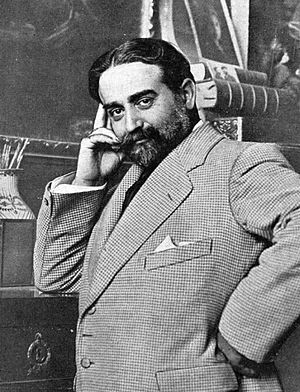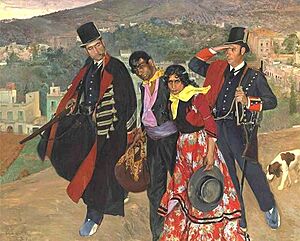Carlos Vázquez Úbeda facts for kids
Quick facts for kids
Carlos Vázquez Úbeda
|
|
|---|---|

1915
|
|
| Born |
Carlos Vázquez Úbeda
31 December 1869 Ciudad Real, Spain
|
| Died | 31 August 1944 (aged 74) Barcelona, Spain
|
Carlos Vázquez Úbeda was a talented Spanish artist. He was born on December 31, 1869, in Ciudad Real, Spain. He passed away on August 31, 1944, in Barcelona. Carlos was known for his paintings, drawings, and even posters.
Biography
Carlos's first art lessons were from his mother, Matilde. Later, he went to the Escuela Especial de Pintura in Madrid. There, he studied with a famous landscape painter named Carlos de Haes.
Carlos received a special scholarship from his home province. This allowed him to study art in France and Italy. He lived in Paris for a while and worked with the artist Léon Bonnat.
In 1892, Carlos received his first official award. It was at the National Exhibition of Fine Arts in Spain. The next year, he won another medal at an art show in Rouen, France. From 1895 onwards, his art was shown at the famous Salon in Paris.
In 1896, Carlos traveled through a region called La Mancha. He was with another artist, Daniel Urrabieta Vierge. They were creating drawings for the famous book Don Quixote. After that, Carlos went to Venice, Italy. He painted portraits for important people there. He even painted Carlos, Duke of Madrid, and his family. Because of this, he was given the special title of "court painter." This meant he was an official artist for royalty.
By 1898, Carlos had moved to Barcelona. He joined a group of artists who met at a famous cafe called Els Quatre Gats. Other artists in this group included Ramón Casas, Santiago Rusiñol, and Pablo Picasso. Around this time, Carlos started designing posters. He also created illustrations for many newspapers and magazines. Some of these were Blanco y Negro and Pèl & Ploma.
In 1901, Carlos married Matilde Garriga Corones. Her family was well-known in Barcelona. For their wedding, the famous painter Joaquín Sorolla painted a portrait of them.
Carlos had his first art show all by himself in 1903. It was at the Sala Parés in Barcelona. Over the next few years, he showed his work many times at the Salon in Paris. In 1906, he was made a Knight in the Order of Alfonso XII. This was an honor for his painting that showed members of the Mossos d'Esquadra (the Catalan police force).
In 1908, his painting called "La Suegra" (The Mother-in-Law) was shown at the Salon. An American newspaper owner, William Randolph Hearst, bought it. Two years later, Carlos won a top prize at the National Exhibition. This was for his painting "The Wounded Torero."
Soon after, his painting "Honeymoon in the Ansó Valley" was bought. It was purchased by Archer Milton Huntington for the Hispanic Society of America. Carlos became a member of this society in 1914.
In 1915, Carlos was chosen to be the President of the Reial Cercle Artístic de Barcelona. In the same year, he won a gold medal at a big exhibition in San Francisco, USA. After this time, his wife became ill and could not move easily. Carlos stopped showing his art internationally. However, he became more active in Spain. This led to a solo art show at the Museo de Arte Moderno in Madrid in 1928.
In 1936, Carlos became a Professor at the Escola d'Arts i Oficis de Barcelona. He also had an art show in Caracas, Venezuela. This was his first overseas show since 1925. Soon after, the Spanish Civil War began. His art studio was broken into, and many of his artworks and papers were lost.
In early 1937, Carlos, his wife, and his daughter left Spain. They went to Marseille, France. Eventually, they settled in Villefranche-sur-Mer. They stayed in a house owned by the artist Raquel Meller. During this time, Carlos painted a lot. He sold his artworks in Paris and Oslo, Norway. He even had a solo art show in Oslo.
They returned to Spain in 1938. They settled in Seville, where Carlos painted a portrait of a military commander. After the war, they went back to Barcelona. One of his first jobs there was to decorate a clinic. It belonged to a famous eye doctor, Ignacio Barraquer.
In 1944, Carlos was named an Academician at the Real Academia de Bellas Artes de San Fernando. This was a great honor for his art. He died later that year from a heart attack. He was painting in his studio at the time.
See also
 In Spanish: Carlos Vázquez Úbeda para niños
In Spanish: Carlos Vázquez Úbeda para niños



